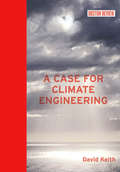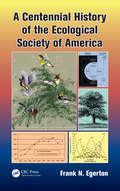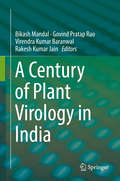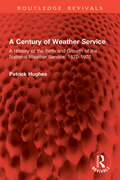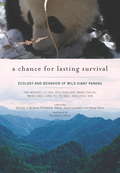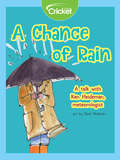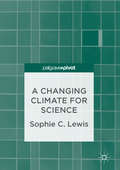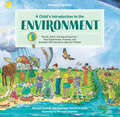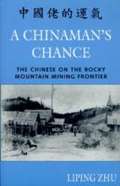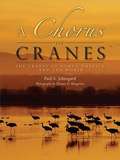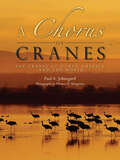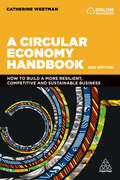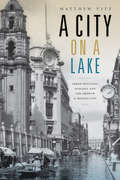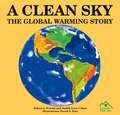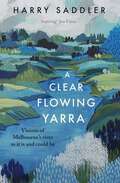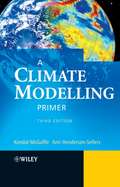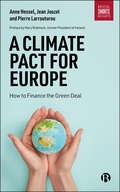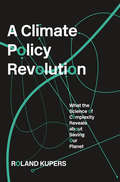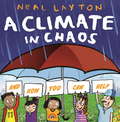- Table View
- List View
A Case for Climate Engineering (Boston Review Books)
by David KeithA leading scientist argues that we must consider deploying climate engineering technology to slow the pace of global warming. Climate engineering—which could slow the pace of global warming by injecting reflective particles into the upper atmosphere—has emerged in recent years as an extremely controversial technology. And for good reason: it carries unknown risks and it may undermine commitments to conserving energy. Some critics also view it as an immoral human breach of the natural world. The latter objection, David Keith argues in A Scientist's Case for Climate Engineering, is groundless; we have been using technology to alter our environment for years. But he agrees that there are large issues at stake. A leading scientist long concerned about climate change, Keith offers no naïve proposal for an easy fix to what is perhaps the most challenging question of our time; climate engineering is no silver bullet. But he argues that after decades during which very little progress has been made in reducing carbon emissions we must put this technology on the table and consider it responsibly. That doesn't mean we will deploy it, and it doesn't mean that we can abandon efforts to reduce greenhouse gas emissions. But we must understand fully what research needs to be done and how the technology might be designed and used. This book provides a clear and accessible overview of what the costs and risks might be, and how climate engineering might fit into a larger program for managing climate change.
A Centennial History of the Ecological Society of America
by Frank N. EgertonCelebrating its 100th anniversary in 2015, the Ecological Society of America (ESA) is the largest professional society devoted to the science of ecology. A Centennial History of the Ecological Society of America tells the story of ESA's humble beginnings, growing from approximately 100 founding members and a modest publication of a few pages to a m
A Century of Plant Virology in India
by Bikash Mandal Govind Pratap Rao Virendra Kumar Baranwal Rakesh Kumar JainThe book is a compilation of research work carried out on plant viruses during past 100 years in India. Plant viruses are important constraints in Indian agriculture. Tropical and sub-tropical environments and intensive crop cultivation practices ideally favours perpetuation of numerous plant viruses and their vectors in India, which often cause wide spread crop losses. Of all the plant pathogens, studies of plant viruses have received a special attention as they are difficult to manage. A large body of literature has been published on the plant virus research from India during past 100 years; however the information is so far not available in one place. This book provides comprehensive information on the biology, molecular biology, epidemics, crop losses, diagnosis and management of viruses and viroids occurring in India. Description of properties of the viruses are provided in the chapters comprising of different genera such as Allexivirus, Begomovirus, Babuvirus, Badnavirus, Carlavirus, Carmovirus, Cucumovirus, Closterovirus, Ilavirus, Mandrivirus, Potyvirus, Tospovirus, Tungrovirus and Sobemovirus. Virus-vector research related to aphid, thrips and whitefly is discussed. The work on the management aspects of plant viral diseases has been described with reference to the conventional, antiviral and transgenic approaches. Further, the quarantine mechanism developed in India for the exclusion of viruses and vectors has also been included. The book also provides useful information about the capacity building on the research and education on Plant Virology in India. Overall, the book covers a wide range of accounts of research findings and innovations in Plant Virology in India during past 100 years. The book will be a resourceful reference to the students, scientists, agricultural professionals and policy makers.
A Century of Weather Service: A History of the Birth and Growth of the National Weather Service, 1870-1970 (Routledge Revivals)
by Patrick HughesFirst Published in 1970, A Century of Weather Service provides a comprehensive history of the birth and growth of the National Weather Service from 1870 to 1970 in America. It discusses important themes such as coping with disaster; American weather pioneers; a military weather service; The United States Weather Bureau; the air commerce age; weather in war; growth of a global weather service; calculated weather risks; the air we breathe; and one world of weather. The book closes with a chronology of the meteorological milestones of the American weather services from 1644 to 1970.This is an important historical work for students of environmental geography and general readers interested in the topic.
A Certain Uncertainty: Nature's Random Ways
by Mark P. SilvermanBased around a series of real-life scenarios, this engaging introduction to statistical reasoning will teach you how to apply powerful statistical, qualitative and probabilistic tools in a technical context. From analysis of electricity bills, baseball statistics, and stock market fluctuations, through to profound questions about physics of fermions and bosons, decaying nuclei, and climate change, each chapter introduces relevant physical, statistical and mathematical principles step-by-step in an engaging narrative style, helping to develop practical proficiency in the use of probability and statistical reasoning. With numerous illustrations making it easy to focus on the most important information, this insightful book is perfect for students and researchers of any discipline interested in the interwoven tapestry of probability, statistics, and physics.
A Chance for Lasting Survival
by David Garshelis Wang Dajun Richard B. Harris William J. Mcshea Pan WenshiFrom 1984 through 1995 a small band of ecologists led by Pan Wenshi from Peking University conducted a study of wild giant pandas in the Qinling Mountains of Shaanxi Province. This project was the first Chinese-led conservation project in China and was conducted during a significant transition period in Chinese history, as the country opened its society and science to the world. The project focused on behavioral observation of wild giant pandas, but evolved to include physiology, nutrition, ecology, land-use policy, and population biology as the staff became more aware that the issues with captive pandas (assisted reproduction, unusual diet, and genetic inbreeding) were not the most critical to survival of wild populations. It is evident in this work that, as the scientists gained knowledge, they came to see giant panda conservation as wrapped in landscape ecology and human/wildlife interactions. The group was seminal in the Chinese government's enactment of a logging ban to their study area by advocating for pandas at the national level. The project was summarized in a 2001 volume, but its publication in Mandarin limited its influence on the greater conservation community. This English version of the original work translates, condenses, and refines the original volume, with added contextual chapters on the importance of this volume and how our understanding of giant panda conservation is shaped by this pioneering field work.
A Chance of Rain
by Ken HeidemanWhat do weather forecasters really know about the weather? An interview with a real meteorologist, Ken Heideman, tells readers what they want to know!
A Changing Climate for Science
by Sophie C. LewisThis book offers a critical exploration of first-hand experiences of practicing climate science. It tackles the pivotal question of what, precisely, constitutes contemporary scientific practice. The author offers an insider's account of the experience of undertaking scientific training and of practicing as a climate scientist in order to examine the gulf between the way that science is perceived and pursued. Lewis delves into this discrepancy, drawing on personal experiences, recent scientific studies, extreme climatic events and political controversies. The book begins by considering the relevance of key concepts such as knowability, credibility, authority and objectivity to the practice of climate science. The following chapters argue that these concepts alone are limiting to our critical understanding climate science and climate change. The book then proposes a new view of scientific practice appropriate for diverse disciplines by arguing that concepts such as transparency and curiosity are equally important to scientific practice as the more familiar key concepts introduced at the start of the book. This book will appeal to climate scientists, social scientists and those interested in the challenges posed by future climate change.
A Child's Introduction To Natural History: The Story Of Our Living Earth-from Amazing Animals And Plants To Fascinating Fossils And Gems (A\child's Introduction Ser.)
by Heather Alexander Meredith HamiltonIn the tradition of Black Dog's best-selling Child's Introduction books, which include The Story ofthe Orchestra and A Child's Introduction to the Night Sky, A Child's Introduction to Natural History introduces readers ages 8 to 12 to the fascinating wonders of our natural world. Highlighting every kingdom of life--plants, bacteria, mammals, birds, amphibians, insects, rocks and minerals--the book is also full of charming and witty illustrations by Meredith Hamilton plus 30 photographs throughout. The book delves into topics like geology; prehistoric times, including fossils and dinosaurs; how animals move and fly; evolution; biomes; and more. Sidebars throughout offer biographies of naturalists like Charles Darwin, Mary Anning, and Charles Henry Turner. Also includes fun, hands-on projects for kids to do on their own or with adults and 5 origami patterns to create your own paper fox, whale, penguin, and more. Beautifully illustrated and designed, this is an entertaining and educational look at our natural history.
A Child's Introduction to the Environment: The Air, Earth, and Sea Around Us -- Plus Experiments, Projects, and Activities YOU Can Do to Help Our Planet! (A Child's Introduction Series)
by Michael Driscoll Dennis DriscollExplore the water, land, and air around us with this entertaining and informative look at our magnificent planet—and learn how your experiments, activities, and everyday actions can help save the environment. This book looks at the wide variety of ecosystems and environmental regions of the Earth, from deserts and forests, to cities and farms, to oceans and ice caps, as well as the atmosphere, weather, energy sources, plants, and animals of each area. Michael Driscoll and professor of meteorology Dennis Driscoll explain the changes to our planet that are currently taking place, including rising temperatures and sea levels, and the effects they can have on our environment. They also profile young environmental activists like Greta Thunberg and Isra Hirsi, and highlight important, everyday actions such as water conversion and recycling that kids can do on their own or with their parents. Also included are fun projects and experiments to do at home like brewing sun tea, creating lightning, and making a smog detector. Packed with facts, experiments, and a removable poster with tips on how to save the planet, this comprehensive guide will inspire kids and their families to think about our planet in new ways and help keep it beautiful and healthy for years to come.
A China Business Primer: Ethics, Culture, and Relationships
by Michael A. Santoro Robert ShanklinThe COVID-19 pandemic underscored longstanding fissures in China’s business relationships with the West. If the West is going to develop a relationship of mutual trust and improve business relations with China in the coming decades, it is imperative to understand how to engage with Chinese thinking on ethics in business—this book explains how. Government officials, businesspeople, and business-ethicists have trouble communicating about issues in ethics, policy, and business across the China-West divide. This book shows how to overcome the us-versus-them mindset plaguing China-West relations by presenting to Western audiences an easy-to-understand yet deeply informed primer on core ideas and perspectives in Chinese cultural and philosophical thought. The book considers original texts of Chinese philosophy and religion, and applies principles from those writings to three business-ethics topics of enduring interest to business executives, government officials, and academics, namely, the protection of intellectual property, assurance of product safety and quality in the pharmaceutical supply chain, and human rights. This book is a must-read for those who want to forge constructive relationships with their Chinese counterparts based on mutual trust and understanding. The book is specifically relevant to business executives, but it should also be of interest to policymakers, educators, and students who seek to communicate more effectively with their Chinese counterparts, in particular about difficult and contentious business, policy, and ethical issues.
A Chinaman's Chance: The Chinese on the Rocky Mountain Mining Frontier
by Liping ZhuIn 1880, what was it like to be Chinese and work in the mines around Boise? This book answers those questions..
A Chorus of Cranes
by Paul A. Johnsgard Thomas D. Mangelsen"Accompanied by the stunning photography of Thomas D. Mangelsen, A Chorus of Cranes details the natural history, biology, and conservation issues surrounding the abundant sandhill crane and the endangered whooping crane in North America. Author Paul A. Johnsgard, one of the leading authorities on cranes and crane biology, describes the fascinating social behaviors, beautiful natural habitats, and grueling seasonal migrations that have stirred the hearts of people as far back as medieval times and garnered the crane a place in folklore and mythology across continents.Johnsgard has substantially updated and significantly expanded his 1991 work Crane Music, incorporating new information on the biology and status of these two North American cranes and providing abbreviated summaries on the other thirteen crane species of the world. The stories of these birds and their contrasting fates provide an instructive and moving history of bird conservation in North America. A Chorus of Cranes is a gorgeous and invaluable resource for crane enthusiasts, birders, natural historians, and conservationists alike."
A Chorus of Cranes: The Cranes of North America and the World
by Paul A. Johnsgard“Since long before medieval times cranes have been considered messengers of the gods, calling annually from on high to remind humans below of the passing years and of their own mortality. Now it is up to humans to take responsibility for controlling our own fate—and also to cry out to protect not only cranes but all the other wonderful creatures that share our increasingly fragile and threatened planetary ecosystem with us." —Paul A. Johnsgard, from the acknowledgments Accompanied by the stunning photography of Thomas D. Mangelsen, A Chorus of Cranes details the natural history, biology, and conservation issues surrounding the abundant sandhill crane and the endangered whooping crane in North America. Author Paul A. Johnsgard, one of the leading authorities on cranes and crane biology, describes the fascinating social behaviors, beautiful natural habitats, and grueling seasonal migrations that have stirred the hearts of people as far back as medieval times and garnered the crane a place in folklore and mythology across continents. Johnsgard has substantially updated and significantly expanded his 1991 work Crane Music, incorporating new information on the biology and status of these two North American cranes and providing abbreviated summaries on the other thirteen crane species of the world. The stories of these birds and their contrasting fates provide an instructive and moving history of bird conservation in North America. A Chorus of Cranes is a gorgeous and invaluable resource for crane enthusiasts, birders, natural historians, and conservationists alike. The University Press of Colorado gratefully acknowledges the generous support of the Iain Nicholson Audubon Center at Rowe Sanctuary, Audubon Nebraska, Ron and Judy Parks, Wagon Tongue Creek Farm, and the Trull Foundation toward the publication of this book.
A Christian's Guide to Planet Earth: Why It Matters and How to Care for It
by Betsy PainterFrom conservation to protecting endangered species to sustainable living, A Christian's Guide to Planet Earth offers a faith-based framework for viewing our responsibility to the natural world as well as practical, biblical ways we can care for the magnificent creation around us.Drawing on science and Scripture, this hope-filled and reader-friendly guide helps us navigate questions about caring for and respecting God's world. With a focus on real-life solutions, this book explores answers to questions such as:What does the Bible say about food shortages, forests, and pollution?How can we make ethical choices about what we eat and what we wear?Why is reducing our carbon footprint a way of loving others?What do animals tell us about God's design for the earth?What simple choices can we make to help recover God's beauty in creation?Four-color infographics throughout highlight the inherent grandeur of the natural world, stirring our hearts to care about the wild and wondrous things God has made. Each chapter concludes with practical tips on how to become better stewards of the Earth, including how to support efforts that make a positive difference in the world.A Christian's Guide to Planet Earth is ideal for:Anyone who wants to make a difference for the planet but doesn't know where to startReaders interested in how stewardship of the water, air, land, and gardens relates to serving God and our neighborBible studies and church small groupsHomeschooling families and networksAnyone who loves God's beauty in natureReaders with questions about how changes to our earth affect the planet and our livesEqual parts philosophical and practical, this guide provides us a deeper understanding of God's love for His creation and the delightful, God-given privilege we have to enjoy it and care for it well.
A Chronology of Ancient Greece
by Timothy VenningThis helpful reference offers a timeline of ancient Greece&’s political and military history. This chronological history begins with the necessarily approximate course of events in Bronze and early Iron Age, as estimated by the most reliable scholarship and the legendary accounts of this period. From the Persian Wars onwards, a year-by-year chronology is constructed from the ancient historical sources—and where possible, a day-by-day narrative is given. The geographical scope expands as the horizons of the Greek world and colonization increased, with reference to developments in politico-military events in the Middle Eastern (and later Italian) states that came into contact with Greek culture. From the expansion of the Greek world across the region under Alexander, the development of all the relevant Greek/Macedonian states is covered. The text is divided into events per geographical area for each date, cross-referencing where needed. Detailed accounts are provided for battles and political crises where the sources allow this—and where not much is known for certain, the different opinions of historians are referenced. The result is a coherent, accessible, and accurate reference to what happened and when.
A Circular Economy Handbook: How to Build a More Resilient, Competitive and Sustainable Business
by Catherine WeetmanWINNER: 2018 Les Plumes des Achats & Supply Chain - The Committee Special Prize As we learn more about the climate and biodiversity crisis, it is clear that how we make and consume things is a major part of the problem. Extraction and processing of materials, fuels and food makes up about half of global greenhouse gas emissions and over 90% of biodiversity loss and water stress. Many modern businesses deplete resources, destroy ecosystems and dump waste and pollution at every stage - harming human health along the way. Governments, businesses and think-tanks see the circular economy as the way forward. Now in its second edition, A Circular Economy Handbook is a guided tour through the concepts and the practicalities. A unique framework systematically explores the range of circular interventions, including product and supply chain design, material choice and supporting business models. How does it really work for business? What circular approaches are emerging in food, fashion, consumer technology, packaging and other sectors? How do these reduce risk, improve resilience and build profitable, future-fit organizations? With over 300 real examples from around the world, this is a must-read for businesses, students and policymakers. This new edition has been extensively updated to include the latest trends, thinking, research and solutions, with a new chapter on packaging and 30 new company snapshots.
A City on a Lake: Urban Political Ecology and the Growth of Mexico City (Radical Perspectives)
by Matthew VitzIn A City on a Lake Matthew Vitz tracks the environmental and political history of Mexico City and explains its transformation from a forested, water-rich environment into a smog-infested megacity plagued by environmental problems and social inequality. Vitz shows how Mexico City's unequal urbanization and environmental decline stemmed from numerous scientific and social disputes over water policy, housing, forestry, and sanitary engineering. From the prerevolutionary efforts to create a hygienic city supportive of capitalist growth, through revolutionary demands for a more democratic distribution of resources, to the mid-twentieth-century emergence of a technocratic bureaucracy that served the interests of urban elites, Mexico City's environmental history helps us better understand how urban power has been exercised, reproduced, and challenged throughout Latin America.
A Clean Sky: The Global Warming Story
by Judith Love Cohen Robyn C. FriendAn introduction for children to the importance of preserving the environment and the significant effects that global warming can have on nature.
A Clear Flowing Yarra
by Harry SaddlerThey say you can't step in the same river twice, and it's true that the Yarra has been hugely changed - but this book is a glorious and timely reminder that things can also be changed for the better.Nature writer Harry Saddler hops, skips and jumps his way along, beside, on and even in the Yarra River from source to mouth, reveling in its hidden beauty, getting close to platypuses, kingfishers, Krefft's gliders and the occasional seal, and meeting many of the swimmers, bushwalkers, ecologists and traditional owners who are quietly and tenaciously restoring the river, patch by patch.Optimistic, inspiring and heartfelt, A Clear Flowing Yarra is a passionate love letter to the river that shapes Melbourne, and an evocative vision of what it is now and what it can be.
A Clear Flowing Yarra
by Harry SaddlerThey say you can't step in the same river twice, and it's true that the Yarra has been hugely changed - but this book is a glorious and timely reminder that things can also be changed for the better.Nature writer Harry Saddler hops, skips and jumps his way along, beside, on and even in the Yarra River from source to mouth, reveling in its hidden beauty, getting close to platypuses, kingfishers, Krefft's gliders and the occasional seal, and meeting many of the swimmers, bushwalkers, ecologists and traditional owners who are quietly and tenaciously restoring the river, patch by patch.Optimistic, inspiring and heartfelt, A Clear Flowing Yarra is a passionate love letter to the river that shapes Melbourne, and an evocative vision of what it is now and what it can be.
A Climate Modelling Primer
by Kendal Mcguffie Ann Henderson-SellersAs a consequence of recent increased awareness of the social and political dimensions of climate, many non-specialists discover a need for information about the variety of available climate models. A Climate Modelling Primer, Third Edition explains the basis and mechanisms of all types of current physically-based climate models.A thoroughly revised and updated edition, this book assists the reader in understanding the complexities and applicabilities of today's wide range of climate models. Topics covered include the latest techniques for modelling the coupled biosphere-ocean-atmosphere system, information on current practical aspects of climate modelling and ways to evaluate and exploit the results, discussion of Earth System Models of Intermediate Complexity (EMICs), and interactive exercises based on Energy Balance Model (EBM) and the Daisyworld model. Source codes and results from a range of model types allows readers to make their own climate simulations and to view the results of the latest high resolution models.The accompanying CD contains:A suite of resources for those wishing to learn more about climate modelling.A range of model visualisations.Data from climate models for use in the classroom.Windows and Macintosh programs for an Energy Balance Model.Selected figures from the book for inclusion in presentations and lectures.Suitable for 3rd/4th year undergraduates taking courses in climate modelling, economic forecasting, computer science, environmental science, geography and oceanography. Also of relevance to researchers and professionals working in related disciplines with climate models or who need accessible technical background to climate modelling predictions.
A Climate Pact for Europe: How to Finance the Green Deal
by Jean Jouzel Anne HesselThe COVID-19 pandemic gives an opportunity to relaunch global economic systems with a better balance between the social and environmental dimensions. There is a need for a scientifically-based step towards a strong Green Deal: a Climate Pact for the EU. Based on a bestselling French book, this English translation provides a summary of the facts on the climate issue, the solutions available and their costs. It outlines the political advantages and challenges current policy, practice and thinking at a time when populist leaders are transforming politics worldwide. This timely book will contribute to a renewed political vision for the EU, the European Economic Area, the UK and Africa.
A Climate Policy Revolution: What the Science of Complexity Reveals about Saving Our Planet
by Roland KupersHumanity’s best hope for confronting the looming climate crisis rests with the new science of complexity. The sheer complexity of climate change stops most solutions in their tracks. How do we give up fossil fuels when energy is connected to everything, from great-power contests to the value of your pension? Global economic growth depends on consumption, but that also produces the garbage now choking the oceans. To give up cars, coal, or meat would upend industries and entire ways of life. Faced with seemingly impossible tradeoffs, politicians dither and economists offer solutions at the margins, all while we flirt with the sixth extinction. That’s why humanity’s last best hope is the young science of complex systems. Quitting coal, making autonomous cars ubiquitous, ending the middle-class addiction to consumption: all necessary to head off climate catastrophe, all deemed fantasies by pundits and policymakers, and all plausible in a complex systems view. Roland Kupers shows how we have already broken the interwoven path dependencies that make fundamental change so daunting. Consider the mid-2000s, when, against all predictions, the United States rapidly switched from a reliance on coal primarily to natural gas. The change required targeted regulations, a few lone investors, independent researchers, and generous technology subsidies. But in a stunningly short period of time, shale oil nudged out coal, and carbon dioxide emissions dropped by 10 percent. Kupers shows how to replicate such patterns in order to improve transit, reduce plastics consumption, and temper the environmental impact of middle-class diets. Whether dissecting China’s Ecological Civilization or the United States’ Green New Deal, Kupers describes what’s folly, what’s possible, and which solutions just might work.
A Climate in Chaos: and how you can help
by Neal LaytonYou've probably heard about climate change. At least I hope you have - because it's REALLY IMPORTANT. It affects all of us living on Planet Earth right now, and everyone and everything that will live on our planet in the future.Our world is warming up, and it's a big problem. Award-winning author-illustrator Neal Layton is here to explain what climate change is, what's causing it and why it's dangerous for animals and humans alike. But he's also FULL of ideas for how you can help! From eating lots more veggies to walking and cycling and thinking carefully about what we need to buy, A Climate in Chaos will get young readers excited about how they can make a difference to keep Planet Earth happy.This brilliant non-fiction picture book, illustrated in Neal's trademark collage style, is perfect for readers aged 5-7 who love nature and want to help the environment.Also available in this series: A Planet Full of Plastic.
